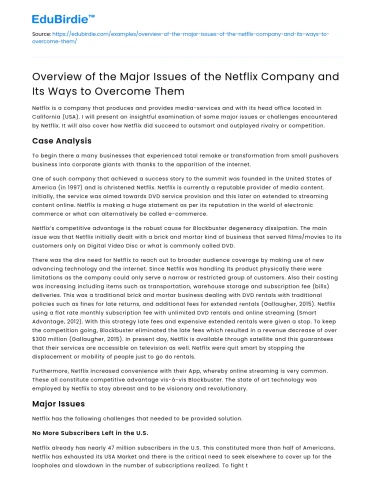Netflix is a company that produces and provides media-services and with its head office located in California (USA). I will present an insightful examination of some major issues or challenges encountered by Netflix. It will also cover how Netflix did succeed to outsmart and outplayed rivalry or competition.
Case Analysis
To begin there a many businesses that experienced total remake or transformation from small pushovers business into corporate giants with thanks to the apparition of the internet.
Save your time!
We can take care of your essay
- Proper editing and formatting
- Free revision, title page, and bibliography
- Flexible prices and money-back guarantee
One of such company that achieved a success story to the summit was founded in the United States of America (in 1997) and is christened Netflix. Netflix is currently a reputable provider of media content. Initially, the service was aimed towards DVD service provision and this later on extended to streaming content online. Netflix is making a huge statement as per its reputation in the world of electronic commerce or what can alternatively be called e-commerce.
Netflix’s competitive advantage is the robust cause for Blockbuster degeneracy dissipation. The main issue was that Netflix initially dealt with a brick and mortar kind of business that served films/movies to its customers only on Digital Video Disc or what is commonly called DVD.
There was the dire need for Netflix to reach out to broader audience coverage by making use of new advancing technology and the internet. Since Netflix was handling its product physically there were limitations as the company could only serve a narrow or restricted group of customers. Also their costing was increasing including items such as transportation, warehouse storage and subscription fee (bills) deliveries. This was a traditional brick and mortar business dealing with DVD rentals with traditional policies such as fines for late returns, and additional fees for extended rentals (Gallaugher, 2015). Netflix using a flat rate monthly subscription fee with unlimited DVD rentals and online streaming (Smart Advantage, 2012). With this strategy late fees and expensive extended rentals were given a stop. To keep the competition going, Blockbuster eliminated the late fees which resulted in a revenue decrease of over $300 million (Gallaugher, 2015). In present day, Netflix is available through satellite and this guarantees that their services are accessible on television as well. Netflix were quit smart by stopping the displacement or mobility of people just to go do rentals.
Furthermore, Netflix increased convenience with their App, whereby online streaming is very common. These all constitute competitive advantage vis-à-vis Blockbuster. The state of art technology was employed by Netflix to stay abreast and to be visionary and revolutionary.
Major Issues
Netflix has the following challenges that needed to be provided solution.
No More Subscribers Left in the U.S.
Netflix already has nearly 47 million subscribers in the U.S. This constituted more than half of Americans. Netflix has exhausted its USA Market and there is the critical need to seek elsewhere to cover up for the loopholes and slowdown in the number of subscriptions realized. To fight the slowdown, Netflix has increased its pricing. This is one can say is quite challenging.
Difficult International Growth
At the beginning of the year, Netflix communicated its expansion to nearly every major market outside of China. Before that announcement, Netflix operated in about some 50 countries, and it had just over 18 million international subscribers or customers. By taking the initiative to venture its business internationally, it exposes Netflix to a category of new prospective subscribers; nevertheless getting this new group or category of subscribers on board was not going to be an easy operation. Though Netflix was growing and excelling in The United Kingdom, Latin America and the Scandinavia, smaller regional competitors began popping up or out springing worldwide. Moreover, Netflix's staggered International rollout has left its library rather deficient in some countries in comparatively to Netflix in the United States of America. Netflix product is less compelling and appealing in many of its newly launched markets. In addition, Netflix is spending enormously to acquire global rights for blockbuster content. So Netflix encounters ferocious competition.
Reliance on Media Companies
Netflix value is sturdily connected to other company's content. Meanwhile concomitantly these companies are competing to grab Netflix viewers. This makes them hesitant in trading their content to Netflix streaming Service.
Tentative Solitions and Competitive Advantage
An array of innovative technologies have aided in giving Netflix a competitive advantage. Via their online streaming, it gave customers convenience as it removed long time wasting as would be with a traditional company. Netflix stored its content (videos) on clouds provided by Amazon. Netflix’s online streaming is done from Microsoft Silverlight Players (Adhikari, Guo, Hao, Varvello, Hilt, Steiner, & Zhang, 2012). Netflix also collect data based on customers preference on movies, analyze them for information, and create a customized genre for each individual subscriber (Madrigal, 2014).
The term 'disruptive innovation’ was first framed by professor Clay Christensen from Harvard Business School and the term turned out to be a compelling way to think about innovation-driven growth (Itonics, 2018). Christensen theory states that every successful and established company will one day be overtaken and threatened by a revolutionary newcomer (Itonics, 2018). An innovation that is disruptive enables a whole new class of consumers at the bottom of a market access to a product or service that were historically very costly for consumers to get. Characteristically Netflix represents a good example of disruptive innovation because originally Netflix mail-in-subscription service was not attractive to Blockbuster’s mainstream customers that rented new releases 'on-demand’. Netflix targeted segments of the population that have been ignored by its rivals, delivering an inferior (but more tailored) alternative, at a lower price and eventually, Netflix moved upmarket by adding the things mainstream customers wanted by innovating and displaced the giants in the business.






 Stuck on your essay?
Stuck on your essay?

